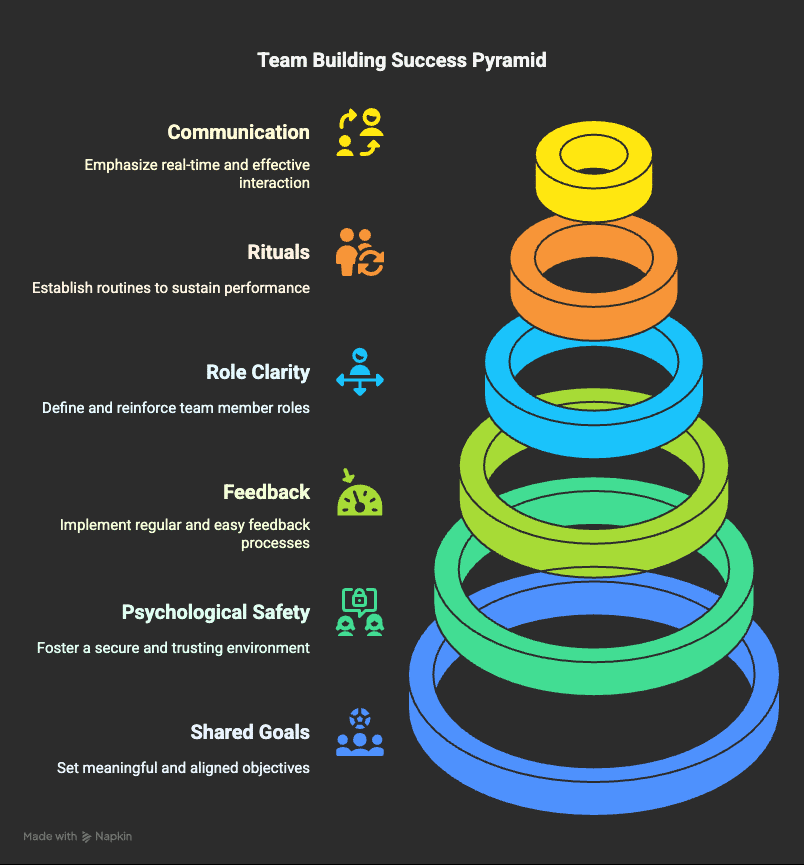Team building success isn’t just about trust falls and off-sites. It’s about alignment, accountability, and results. At Champion PSI, we’ve coached hundreds of executive teams through the highs and lows of team dynamics. And one thing is clear: when leaders invest in team building success strategically, performance doesn’t just improve—it compounds.
This blog breaks down seven no-fail strategies that drive real, measurable results for leadership teams. If you’re ready to shift from dysfunction to cohesion, from busy to aligned, you’re in the right place. For additional strategies, explore our executive coaching for entrepreneurs approach.
Curious how Champion PSI helps teams align and execute? Explore our executive coaching services.
Overview of the Topics
Team building success starts with clarity and ends with execution. In this blog, we’ll unpack:
- Set Shared Goals That Actually Matter
- Create Psychological Safety—For Real
- Make Feedback Frequent and Frictionless
- Clarify Roles (Then Reinforce Them)
- Build Rituals That Lock in Performance
- Prioritize Real-Time Communication
- Real-World Example: Microsoft’s Hybrid Team Building Success
Let’s dive in.

1. Set Shared Goals That Actually Matter
Team building success hinges on shared purpose. Without clearly defined, emotionally resonant goals, even the best teams drift. Forbes outlines several executive decision-making strategies that support this, including mindful alignment with core objectives.
Shared goals function as a compass for all team activity. They create alignment across departments, prevent silos from forming, and empower individuals to prioritize their work. When a team knows exactly what it’s driving toward, decision-making becomes faster and more autonomous.
One key tip: make the goals visible. Use dashboards, weekly meetings, or even whiteboards to reinforce them. Clarity isn’t a one-time event—it’s a rhythm you reinforce.
Try this: Start every Monday by revisiting your top three team goals. Ask, “What are we doing this week that gets us closer?” It builds rhythm and realignment. For more insight, check out these leadership development principles.
2. Create Psychological Safety—For Real
Google’s Project Aristotle found that psychological safety was the #1 trait of successful teams. When people feel safe to speak up, disagree, or share half-baked ideas, creativity and cohesion soar.
This doesn’t mean coddling. It means creating space where truth can be spoken without fear of humiliation or punishment.
Psychological safety is built through repetition, modeling, and accountability. Leaders who admit when they’re wrong, ask for feedback, and respond to mistakes with curiosity instead of judgment set the tone for the entire team.
Champion PSI’s executive coaching helps leaders develop the self-awareness and presence required to cultivate this trust consistently. Harvard Business Review’s breakdown of the leader as coach shows how developmental leadership builds high-performing cultures.
One quick win: kick off your next meeting by asking a team member to share a recent failure and what they learned. Model it first. Normalize it. Then watch how quickly authenticity follows.
3. Make Feedback Frequent and Frictionless
Feedback isn’t criticism—it’s an investment in alignment. Normalize it, and you’ll transform team performance. As McKinsey’s insight on leadership strategies reinforces, developing leaders at every level is key to scalable performance.
Most teams wait for annual reviews. High-performing teams do feedback in real time. Gallup’s strengths-based leadership research shows how ongoing feedback drives long-term performance gains. Good feedback is specific, timely, and delivered with the intention to elevate. Use frameworks like SBI (Situation, Behavior, Impact) or Start–Stop–Continue to remove the emotional sting and make it habitual.
Looking to implement this quickly? These winning team tips can help embed feedback into your team culture.
4. Clarify Roles (Then Reinforce Them)
Ambiguity kills momentum. When team members don’t know who owns what—or worse, when they think they own the same thing—trust erodes. And as CEO decision-making research shows, clarity in structure enables leaders to act more decisively.
Roles and responsibilities must be more than job descriptions—they need to live in the day-to-day. Leaders should consistently reinforce ownership during meetings, updates, and through tools like OKRs or project briefs. Use role cards, RACI models, or even a single-page team charter that spells out who does what and why. Then revisit them often.
5. Build Rituals That Lock in Performance
Rituals aren’t fluff. They’re psychological anchors. Whether it’s a 5-minute “Monday Momentum” call or a monthly team review, great teams run on rituals. These checkpoints create rhythm, boost morale, and ensure nothing critical falls through the cracks.
Rituals reduce cognitive load and make behavior repeatable. They signal what matters. A team that does a “Win of the Week” check-in every Friday builds momentum and morale. A team that does a “Lessons Learned” debrief after every project improves faster.
Bonus tip: Rituals work even better when teams co-create them. Let the group define what works—and why.
6. Prioritize Real-Time Communication
Slack. Email. Meetings. Loom videos. With so many channels, the message can get lost. Define when and how your team communicates. Urgent = phone. Discussion = live meeting. Info share = async doc. Don’t leave it to chance.
Communication architecture reduces confusion, misalignment, and passive-aggressive backlogs. It fuels team building success by keeping clarity front and center. And it pairs naturally with these leadership skills in the workplace that every team should prioritize.
Bonus tactic: Run a team-wide audit on tools. What’s useful? What’s noise? Cut where needed. Simplicity is clarity.
7. Real-World Example: Microsoft’s Hybrid Team Building Success
In August 2022, Microsoft’s Identity division partnered with Teambonders to host a hybrid team-building event called “Survey Showdown” for their summer interns. The event combined in-person participation at Microsoft’s Redmond office with virtual attendees from locations including California, Dublin, Vancouver, and Atlanta. Team Bonders+1Sherlocked+1
The primary objectives were to enhance team bonding, improve coordination, build trust, and support diversity and inclusion initiatives. The game-show-style activity featured high production value, complete with visuals, sound effects, music, and a dynamic host, creating an engaging and inclusive experience for all participants.Team Bonders
The results were impressive: the interns reported increased camaraderie, stronger cross-team collaboration, and a more inclusive environment. The hybrid format allowed for meaningful connections without the need for extensive travel, demonstrating that well-executed virtual events can effectively bridge geographical gaps and foster a cohesive team culture.Team Bonders
FAQ
What does team building success look like in practice?
It looks like alignment, trust, and execution. Teams don’t just feel good—they hit goals faster, solve problems smarter, and navigate conflict cleanly.
How do you measure team building success?
Metrics might include engagement scores, 360-feedback results, retention, or even velocity on key objectives. The best measure? Progress toward what actually matters.
Can remote teams achieve true team building success?
Absolutely. It requires more intention, better tech, and consistent rituals—but remote teams can be just as connected, if not more so.
What’s the biggest mistake leaders make in team building?
Treating it as a one-time event. Team building success isn’t a workshop—it’s a system of habits, communication, and alignment.
How often should we revisit our team strategy?
Quarterly at minimum. Ideally, teams revisit key goals and norms every month—even briefly—to stay aligned and proactive.
Team Building Success Starts Here: Conclusion
Team building success isn’t a mystery. It’s a discipline. One that can be built, repeated, and scaled across leadership teams when done right.
If you’re ready to lead a team that’s aligned, engaged, and firing on all cylinders—you don’t need more tools. You need better systems.
Ready to get started? Book a free 30-minute call with an expert coach to explore how team building success can support your goals.










